This landscape project will be on the freshman residential hall, Huber. After the building’s completion in 1917 it has served many uses; it was initially a preparatory school before becoming a dormitory in 1999. The goal of this research project is to determine what were the varying uses of Huber Hall over the century it has been around and how the hall adjusted to the college’s changing culture. Since societies are always changing, we expect a great insight into Huber Hall and how residents interacted with it. As many first year students covet the opportunity to live in this residence hall, we felt it was a good place to explore and learn more about.
Throughout the semester Simon, Shane and I researched the History behind Huber Hall. Before 1917, the Building functioned as a Hotel. Gettysburg transformed the building into the Gettysburg Academy, a feeder school for women for Gettysburg college before the Great Depression, when the building was closed. Later, in 1935, the building became a women’s dorm.
The women’s dorm gives the building intrinsic value to the past. Today, the first floor to the building is still all-women, showing that the school is still in touch history. It was called a feeder school building because the educational level opportunities for the women were so high. This is one example of the many opportunities Gettysburg gives/gave to remedy differences in gender and race.
Huber Hall was refurbished in 1999, the common room’s fireplace was replaced with an elevator. The 1st and 3rd floor classrooms from the academy became the 1st and 3rd floor common rooms. The 2nd floor kitchen has been kept for use. The tennis court has been paved over for a parking lot. The laundry room was the first floor kitchen before it was converted. The general face of the building has remained the same.
Old pictures vs new pictures
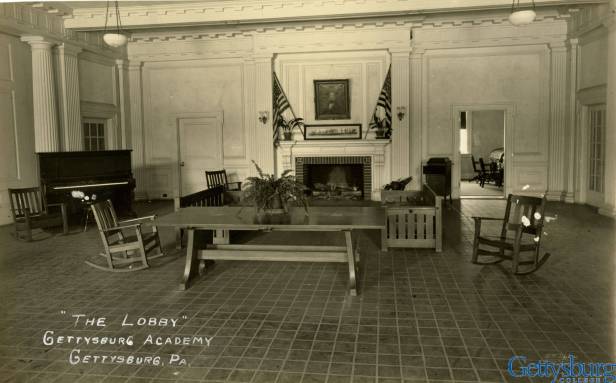

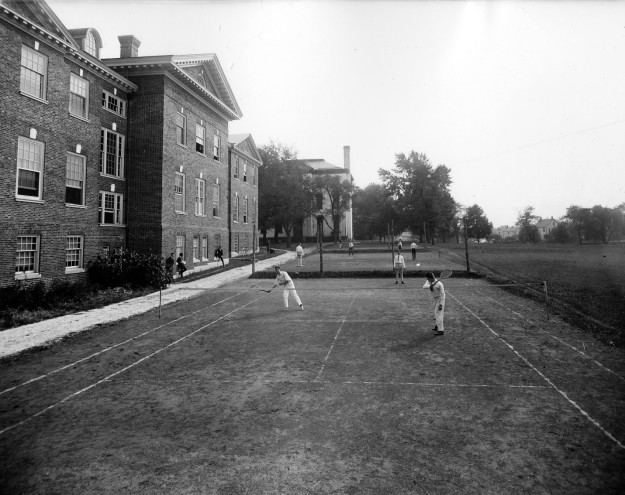

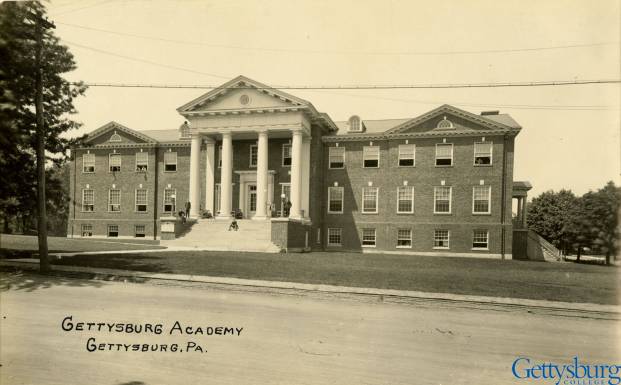

Rachael:
The main idea of the cultural landscape approach is to view history through multiple perspectives and multiple sources of information including written history, cultural history and material culture. Because there are an immense number of gaps in our knowledge about the past, it is logical that multiple perspectives give different portions of the whole story, so it is only after reviewing all resources do we get an idea of the larger picture. Further, the landscape approach connects the building with the people who have used and lived in the building over the years as well as the people who owned the building and the different functions the building has had.
Cultural landscapes are areas of significant social meaning due the interactions between the people and the land. We are also able to see connections between Huber and the other buildings. For example, after Huber Hall became a dorm, Huber Hall and Stevens Hall were the male and female dorms, respectively, at the time. Because of this connection, we are better able to understand the roles of both dorms in the past. Moreover, we also we can also look at the people who lived on the land. As previously stated, Huber has had many uses. How do each of these uses affect the current building and would people knowing about the building’s past cause opinions and thoughts about the building to change? How can we create analogies between the current building its counterpart of the past? Questions like these enable us to better understand the importance and impact of Huber in both the present and the past.
The landscape approach affectively builds a groundwork for research-gathering tactics and research questions about the past. It enabled us to track Huber Hall through multiple perspectives and sources to get a well-rounded picture of the past of the building, culturally and physically.
Shane McWilliams : I have learned so much about Huber Hall, more than I anticipated. I originally thought Huber Hall had always been a dorm room for residents here but the deeper we looked into the history of the building, the more I learned. First, the architecture of the building has changed slightly, most visible on the steps out front. The most obvious changes are apparent in the parking lot, which used to be full of tennis courts. Before Gettysburg College purchased the building, it functioned as a hotel. Once bought, the college used it for women right before the Great Depression. About a Century later, it became an all women’s dorm.
I feel like there are three types of views towards this building: from outside of Gettysburg, students who attend the school but have not or do not live in Huber Hall, and those who live in Huber Hall. I currently live in Paul Hall, while Simon lives in Huber himself. Since I do not live in Huber, I cannot get the complete grasp of the feeling and interior design, but I did live there in the summer while attending a soccer camp, so it is not completely foreign to me. People who do not go to Gettysburg themselves would just think Huber Hall is an ordinary residential building for students, but they are wrong. It has intrinsic value as a war was fought on the very ground it stands on. The building shape has not changed one bit, implying that the traditions and values that were held back in history are still true to the day. The specialness of the building grows more and more with each blog post. It truly is an amazing building, with an even more interesting history.
Rachael:
Throughout this semester, my view of Huber Hall has changed dramatically. Previously, my knowledge of the hall was quite limited. I had never even visited the hall. It stood out among the freshmen dorms because of the notorious all-women’s first floor and the flooding that sometimes occurred there. Throughout this project, I have learned about when Gettysburg acquired Huber and its past uses, including a hotel, an all-women’s dorm, and an Academy. I learned how the culture around the building changed. It used to be a communal place, but now the tennis fields have been replaced with a parking lot. I also see how it has remained constant throughout the years. The first floor is still an all-women’s floor and a picture of the building’s namesake still hangs in the common room. The building is still a communal area, but only residents generally occupy Huber. Within our group, only one member lives (or has lived) in Huber Hall: Simon. Because of that, he probably feels more attached to the building than the rest of us. Learning about a building while living in it instills a sense of pride that Shane and I do not feel. Like I mentioned previously, the area surrounding Huber has changed. Previously, the parking lot was two tennis courts. It functioned similar to how Stein Lake functions now. Previous generations would have a different perspective of Huber Hall because Huber was more geared towards community space. Now, Huber is one of six first-year dormitories. With both the increase in dormitories and Huber losing its women-only status, Huber’s uniqueness in the campus diminished. That change affects how current Gettysburg students and students of the past view the Hall. The students of the past probably had more connections and memories of the hall than the average student today does. They probably had more fondness to the building because of those memories. To students today who did not live in the building, it is indistinguishable from the other first-year dorms. Before this project, I did not know which building in East quad was Huber Hall.
Simon Velez
This project has been quite the learning experience for me, especially since I live in Huber Hall. When I first arrived on campus I heard a rumor that Huber Hall used to be a Hotel, that was the reasoning behind the big rooms. When I was given the opportunity to research Huber Hall for a class, I leapt at the chance, and I learned a great deal. For starters I didn’t realize Huber Hall was actually a school, explaining the chalkboards found in 2 of the common rooms, this would also explain our kitchen. The other things I learned were that the parking lot used to be a tennis field, and that the elevator in Huber was a fireplace. Now, I’m learning that the cultural landscape of the school is changing. For example, the tennis field fell out of favor because tennis is not as largely popular as it once used to be, so the school decided to pave it over because more and more people were getting cars. Another thing I’m learning about the school’s culture is how the school wants people to form strong life-long bonds with their peers. This is integral to the culture because it is establishing a unique community amongst each grade level. People looking at the college at face value will probably see a party school given the abundance of Greek life, however this is far from true because Gettysburg college is about the bonds you form in college, and Greek life happens to play a big part in that. Now compared to the previous generation, a lot has changed but a lot has stayed the same, the aesthetics and styles may have changed, but the ideals have largely remained the same, with those who go to Gettysburg joining a sort of extended family.
Huber Hall is a historic building on campus thus it has relations with many other buildings on campus. Currently it functions as a first-year dorm, one of six. This status gives it a relationship with the other freshman dorms: Hanson, Patrick, Rice, Paul and Stein. The three first-year dorms in East Quad are Patrick, Hanson and Huber, while the West Quad houses Rice, Paul, and Stein. Also, Huber Hall has a relationship with Stevens Hall, as they were both build around the same time. Two of the notable similarities between the buildings are how they have been re-purposed and their close proximity to each other. Neither of these dormitories were originally meant to be as such. In addition, Huber has a relationship with the Huber lot where events occur and the weekly food truck parks. That parking lot also has changed significantly over the last couple of years. From the last post, we can see that the parking lot was a tennis court in the 1930s, today the tennis courts are on the other side of the campus. Lastly, Huber has a relationship with the Gettysburg college library Musselman. In addition to Musselman being an important building on campus, they are both named after notable figures in Gettysburg college history. Specifically, patrons to the college, who not only donated money, but were key administrators who contributed greatly to the college’s success. A link to view these locations on a map is provided below.
https://drive.google.com/open?id=1nxOlfUOqGjV9dQNtXciiSSnziXc&usp=sharing
Huber Hall used to be the Gettysburg Academy, a prep school for Gettysburg College. Due to the Academy being a first-year residential hall now, the landscape has changed.
Lobby/Common Room

(Huber Hall. n.p.: Special Collections, Gettysburg College, 2007. GettDigital : Gettysburg College Digital Collections. Web. 7 Mar. 2017.)

Back in Huber Hall’s past it used to be known as the Gettysburg Academy, a prep school for Gettysburg college. In the original photo the space seen is a Lobby, it seems as though potential students would wait for the headmaster, or principle there. The room on the right seems to be a study room with desks, or perhaps were potential students did an entry exam. The newer photo has turned the room into a common room. The obvious difference between then and now is that the fireplace has been removed in favor of an elevator. Emergency lights were installed for the common room, as well as new chandeliers, what’s not seen in either picture is the room on the left. Today it is an office, I would only assume it was still an office back then as well. Also not seen in the picture, the modern day common room has a ping pong table and television for entertainment. The needs of the space changed when the needs of the building changed, when the school closed down, it was later opened as a dorm for the college students, and the school’s lobby became the dorm’s main common room.
Rear of Gettysburg Academy/Huber Hall

View of tennis games behind Huber Hall, circa 1920
William Tipton, title unknown, 1920-1930, Date Accessed: 3/8/2017, Gettysburg Daily, http://www.gettysburgdaily.com/the-old-gettysburg-college-observatory/
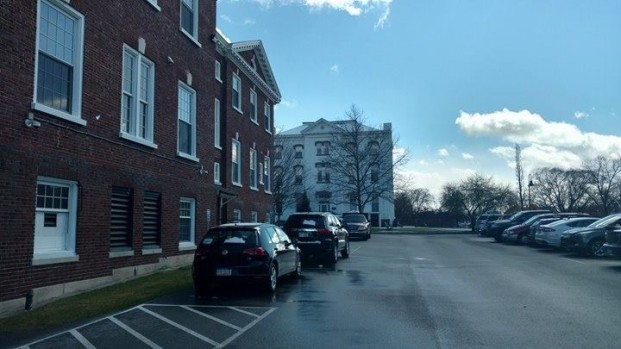
The parking lot behind Huber Hall in Gettysburg, Maryland. Photo by Rachael Kelly, 2017. Used by permission.
I chose this image because it shows how Gettysburg campus, not just Huber itself, has been changed and updated; we get to see the surrounding scenery and buildings near Huber. Stevens Hall is visible in both photographs as well as lots of nearby trees and dirt paths between buildings. The tennis courts that were at one time behind Huber is now a parking lot. A spot that was once for gathering is not a place to store cars. In the older photo, we can see people lounging about; the building was once a common area, much like Stein lake is now. There are also slight changes to the outside of the building. Currently, there are porticos outside the back doors of Huber, but they are not in the older picture. Some of the bottom windows have also changed; they seem to have a metal covering, possibly to increase safety. Before, the building was not a dorm, so security while people were sleeping was not a concern. The changes to the outside and surroundings of Huber Hall show the change of use of Huber hall.
Front of Huber Hall/Gettysburg Academy

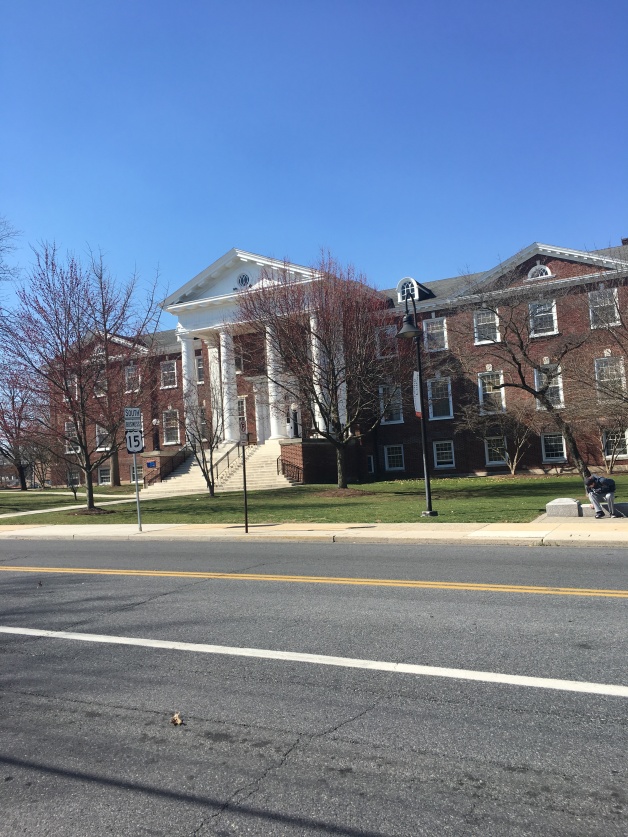
I chose this image because the similarity is astounding. The only difference is in nature, or in other words, the trees and grass landscape out in front of building. The architecture of the building is still true to it’s original creation which represents something special. It shows that the institution still uphold the same values as it did decades ago. Over time, things are created and some things fall apart. But, Huber Hall has stood strong with it’s central, core meaning. Although it was used differently in the past time, the intrinsic value of the building has not changed, which it makes a special location on this campus.
Huber Hall sits right on sacred ground. Men fought to the death during the Civil War in the second half of the 18th century. Next to the building, which houses first year students and has history of being an educational building, sits a monument. This monument showcases an Ohio artillery battery which was used to protect the Union forces. This building is a remembrance of special events over the course of time, from the building itself to the ground with which it lays on. It is unique in its architecture and style, which we can see in the following photo.

However, Huber Hall was not originally a dormitory, although it has functioned as one for many years. Before the college acquired the building, it functioned as a hotel. After Gettysburg college bought the building, the building became known as the Gettysburg Academy building. The Academy building housed a feeder school for women for Gettysburg college before the Great Depression, when the building was closed. Later, in 1935, the building became a women’s dorm.
One of the things that ties Huber to the past is the picture of Charles Huber, the building’s namesake, in the common room. This picture is a literal tie to the past and the history of Huber Hall. Another tie is the first floor of the building. The first floor only houses women, showing Huber’s past as a women’s dormitory.
The grand size of Huber Hall emphasizes its role as a dormitory. The main common room alone is massive and the actual living quarters are the biggest ones on campus. Now the consensus on campus is that Huber Hall is the primer freshman dorm on campus. Each room is the equivalent of a triple in other dormitories on campus. However, the sizable rooms are a tradeoff for subpar bathrooms that only fit a few people and become messy quick. Overall Huber Hall is the greatest dormitory, but not only because of room size, but also because, of its amenities.
Huber Hall is one of two freshman dorms with central air and a kitchen. Huber’s central air system is highly coveted for the warmer months of the year. Other freshman dorms on campus do not have this feature. The other desirable feature of Huber is its kitchen. Many students in Huber and other dorms use it to cook their own meals when the cafeteria is not serving anything good that day.
The terms Absolute Time and Space, Relative Time and Space and Representational time and space is discussed in the book History is in the Land: Multivocal Tribal Traditions in Arizona’s San Pedro Valley by T. J. Ferguson and Chip Colwell-Chanthaphonh (2006, University of Arizona Press).
Absolute Time and Space is reality, or as the book puts it, the physical world. Absolute time and space consists of exact locations and dates, using longitude, latitude, and other measurements. This allows us to create a linear, chronological calendar of places and events that happened in specific locations. For example, Huber Hall is located at 39°50’11.4″N 77°13’53.9″W and many first year students moved into Huber on August 24th, 2016 for the 2016-2017 school year. Relative, or relational, time and space consists of separate, individual locations or times in relation to other events, locations, or times. This relation marks specific, unique events, which makes the boundaries of time and location more flexible and less exact. For example, Stevens hall is between Huber Hall and the Admissions Building. Many students moved into Steven’s Hall one week after students moved into Huber. Lastly, Representational time and space is different from both absolute and relative as it does not specify any event in time. It is full of beliefs and ideals of different cultures. An example could be a map or a flag, which has a bigger meaning than just the sight of it.
Absolute and Relative Space overlap in an obscure way: in order to describe relative space, we must first have an absolute space because absolute space requires a reference point. For example, in order for me to describe where Huber Hall is as a relative space to someone, that person must know a building or monument near Huber. That person must know the absolute space of that structure in order to find Huber Hall via my directions. Absolute and Representational space also overlap. Absolute Time and Relative Time overlap in similar ways: in order for people to know which day, month, and year is exactly one year after Huber became a dormitory, the absolute information about that day must be known. We can also use the two in conjunction to be more specific Representational Space can be described using any of the three types of time: an exact date, sometime after an exact date, or a not exact or general date. While we can use Absolute Space and Time to describe Relative Space and Time, using Relative Time to describe another Relative Time is not as effective or specific. Also, a specific building in on campus resides inside the Relative Space of campus, just like a specific date of Huber Hall occurs between the present and the day construction finished.
These types of space and time live within one another, but they are also separate. It is possible to have Absolute Space and Absolute Time without any of the others. Adding Relative Time and Space would only put the Absolute Time and Space into a better perspective. They are also separate in the fact that they are mutually exclusive or disjoint: while we can describe location or time in different ways, a single description can only be exactly one of the three ways: absolute, relative or representational. To further improve this model, I would suggest that the authors discourage the use of Relative Time and space since it is not specific unless they are generally stating where they are in terms of the United States or the world. Using Relative Time and Space should only be in conjunction with Absolute Time and Space.
Simon Velez – First Year student from Philadelphia, PA. Anthropology major and possibly history duo major with interests in Archaeology and the history of human exploration.
Rachael Kelly – Sophomore Student, and Math major.
Shane McWilliams – First Year student, Economics Major and Political Science Minor.

